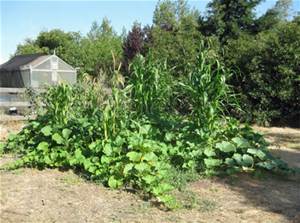Garden Update
I pulled up the last of the sunflowers this past week. Thanks again to Joe Raiden for helping me with that task, It went easier this week…probably due to the little bit of rain we got this past week! So grateful for the rain!
I mentioned last blog post that I am going to plant a Three Sister’s Garden next year. I have 3 raised beds that are about 4 by 8 feet. So, this is really not enough space to plant sweet corn. We have a decent sized back yard, and there is room for more garden but I keep thinking we are moving so I have not taken the initiative to start any more garden beds. It appears that we are going to be staying here for at least another 3 years so I am ready to move ahead with starting a new garden bed. Also, I am curious to try a new method of clearing a space for a garden.
Starting at about 1 min 37 seconds in the YouTube video, it shows a method of putting down compost, then cardboard, and finally wood chips. Then, you let that sit for 5 months. So, we are going to try this method in the backyard and then use that area to plant our Three Sister’s Garden next summer.
What is a Three Sister’s Garden?
Story of the Three Native American Sisters
The three sisters way of planting originated with the Haudenosaunee tribe. The story goes that beans, corn and squash are actually three Native American maidens. The three, while very different, love each other very much and thrive when they are near each other.
It is for this reason that the Native Americans plant the three sisters together.
First, decide on a location. Like most vegetable gardens, the three Native American sisters garden will need direct sun for most of the day and a location that drains well.
Next, decide on which plants you will be planting. While the general guideline is beans, corn and squash, exactly what kind of beans, corn and squash you plant is up to you.
Beans – For the beans, you will need a pole bean variety. Bush beans can be used, but pole beans are more true to the spirit of the project. Some good varieties are Kentucky Wonder, Romano Italian and Blue Lake beans.
Corn – The corn will need to be a tall, sturdy variety. You do not want to use a miniature variety. The kind of corn is up to your own taste. You can grow the sweet corn that we commonly find in the home garden today, or you can try a more traditional maize corn, such as Blue Hopi, Rainbow or Squaw corn. For extra fun, you can use a popcorn variety too. The popcorn varieties are still true to Native American tradition and fun to grow.
Squash – The squash should be a vining squash and not a bush squash. Typically, winter squash work best. The traditional choice would be a pumpkin, but you can also do spaghetti, butternut or any other vine growing winter squash that you would like.
Once you have chosen your beans, corn and squash varieties, you can plant them in the chosen location. Build a mound that is 3 feet across and around a foot high.
The corn will go in the center. Plant 6 or 7 corn seeds in the center of each mound. Once they have sprouted, thin to just 4.
Two weeks after the corn has sprouted, plant 6 to 7 bean seeds in a circle around the corn about 6 inches away from the plant. When these sprout, also thin them to just 4.
Last, at the same time as you plant the beans, also plant the squash. Plant 2 squash seeds and thin to 1 when they sprout. The squash seeds will be planted on the edge of the mound, about a foot away from the bean seeds.
As your plants grow, gently encourage them to grow together. The squash will grow around the base, while the beans will grow up the corn.
A three Native American sisters garden is a great way to get kids interested in history and gardens. Growing corn with squash and beans is not only fun, but educational too.
Information about Three Sister’s Garden taken from Gardening Know How




